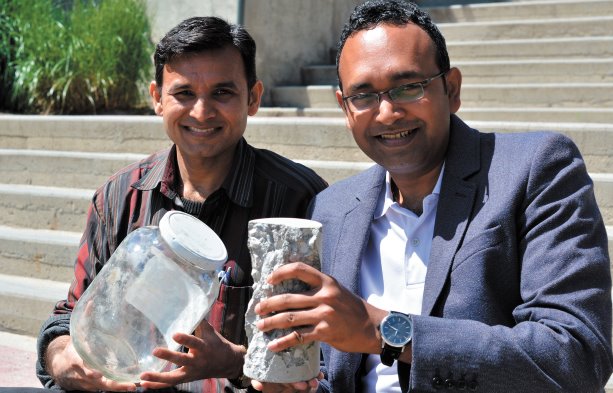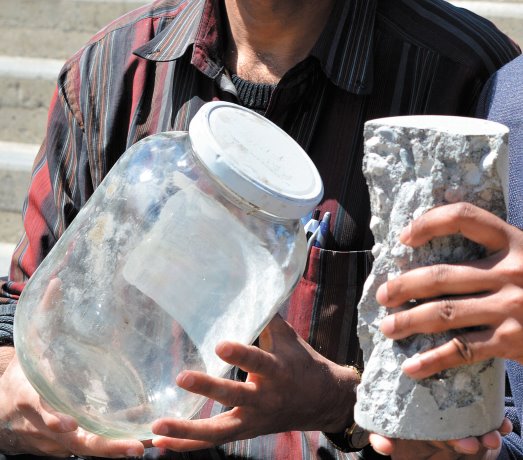A significant finding resulting from the work of two University of BC Okanagan campus research engineers who controlled alkali-silica reaction (ASR) when using glass in a mortar mix is the potential for reducing fly-ash content as Canada’s supply of fly-ash is predicted to diminish.
ASR or concrete cancer (a reaction between the silica found in sand and glass and the alkali in the cement used in mortar and concrete production that causes map-like cracks to appear) has been a topic researched for decades, said Matt Dalkie, technical chair of the BC Ready-Mixed Concrete Association. "It is a no-end issue," he said as issue as supply and demand of materials, social and environmental constraints and costs continue to change the way that concrete is made.
Dalkie said aggregate and other materials are pre-tested for their reactive responses and ingredients to mitigate the impact have been added.
"Typically the ASR is dealt with through supplementary cementitious materials (SCM)," he said, adding these are items such as fume silica and fly-ash. These materials stop the ASR that can cause water absorption and expansion leading to cracks and weaknesses.
Dalkie said fly-ash, with its beneficial properties and once a landfill item, is a residual product of coal power generation. Alberta, a supplier, will start phasing out coal generation beginning in 2018 and finishing by 2030. Quebec has also announced the phase out of coal-power generation by 2030. Dalkie said the ready-mixed industry is aware that shortages are coming and research – such as that at the UBC Okanagan campus and elsewhere – is becoming increasingly important to see how ASR can be dealt when substitution products are used in concrete production.
UBC Okanagan associate professor of engineering Shahria Alam, with PhD student Anant Parghi, were able to replace 25 per cent of the cement used in making a mortar mix with ground glass. In the study, it was found that by adding a water-based, synthetic rubber polymer, fly ash, and glass powder to the concrete mixture, they were able to effectively neutralize any ASR effects and provide a product "that was 60 per cent stronger than what was previously believed possible," says Parghi.
Alam said the focus on the work was directed at utilizing discarded waste glass and the glass used was derived from the Kelowna landfill. But, the work also was able to show that the amount of fly-ash used in the mortar, despite the high silica content in the glass and aggregate, could be lowered and the ASR did not result. The polymer used in the mix served as binder in the mortar.
"We know the price of fly-ash is going to increase in the future," he said, adding that using less can help the concrete industry stabilize prices as scarcities occur.
"We have not looked at it as much as we should," he said.
"But, we know that we get the best results using fly-ash but we also get acceptable results without it."
Alam said that a savings will also occur on the production side as 25 per cent ground glass can be substituted for cement. "Cement is the most expensive material in concrete," he said.
But, the jury is still out as to how much glass, which is not biodegradable and can last centuries in landfill, will cost commercially rather than salvaged from landfill as it requires washing and processing into powder.
Metro Vancouver’s domestic recycling program and numerous bottle depots captures most of the waste glass and it is directed toward Enviro-Corp Recycling, a subsidiary of United Concrete & Gravel, based in Abbotsford, said its marketing manager Wayne Elias.
"These stories about all the glass in landfill — I don’t know where they come from. There are so many sources and streams for collecting glass today that we probably get 80 to 90 per cent coming in through the recycling stream. There is very little hitting the landfill today."
Elias said there is a cost factor associated with using glass in concrete as it needs to be pulverized into a powder. That can add to the processing cost as opposed to simple crushing. Glass is not an economical viable alternative to supplementing aggregate in B.C., but it may have potential for cement depending on the end pricing that is achieved, Elias said.
A ton of aggregate prices out on average about $15 a ton while crushed glass sells at around $100 a ton.
"We are trying to build value," he said, so the company is looking for markets that will pay more than the price it receives for crushing glass and returning it to bottle manufacturers, which are the bulk of its market. Reducing the glass to a powder form would also require further manufacturing in the form of a ball mill and add to the production costs.
In Saskatchewan, a CBC report in 2014 found that most of the glass collected from household blue boxes in Saskatoon and Regina still goes to landfill. In the Yukon, in early 2016, an estimated 60 per cent of glass was still goes to landfill despite reuse of beverage bottles and some use of ground glass in landscaping.
The high cost of transporting glass south negates any benefit of recycling.
The economics of using glass powder in concrete production has been studied internationally. American research papers as early as 2001 looked at substituting waste glass for aggregate and its potential for substitution where aggregate supplies are limited. In more recent years, the shift has focused on glass to replace cement because of the quest to make concrete a greener product.
In the October 2012 issue of Contractor and Building Materials a research paper titled "Durability of mortar using waste glass powder as cement replacement" looked at 10 and 20 per cent substitution of waste glass powder and found it feasible and contributing to sustainable construction. The same year, researchers at the Michigan State University, also ran trials replacing 20 per cent of the cement with ground glass.
In 2013, the International Journal of Emerging Technology and Advanced Engineering carried as study by three engineers from the Pondicherry Engineering College in India which found that glass powder could be to replace up to 40 per cent of cement and that particle size (less than 75 micrometers) played a role in mitigating ASR.
The use of glass in concrete has been more commonly found in decorative uses such as countertops or decorative exterior walls, but has had limited in its use in structural concrete construction.

Two University of BC engineering researchers replaced 25 per cent of the cement in a mortar mix with glass powder and were able to control alkali-silica reaction, a chemical reaction that occurs when silica in sand and glass reacts with the alkali in cement. The researchers used lower amounts of fly-ash to mitigate the chemical reaction but also used a polymer as a binder in the mix.
Photo: UBC Okanagan Campus"










Recent Comments
comments for this post are closed